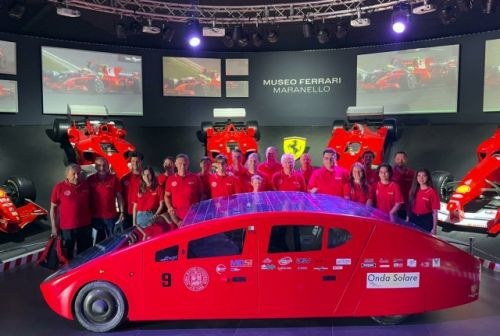Emilia 5, the new prototype of a solar-powered car developed by the University of Bologna, MOST, and Onda Solare, was officially unveiled at the Ferrari Museum in Maranello. The event was attended by the Mayor of Maranello, members of the Board of the Ferrari Museum, directors of the Higher Education Institution 'A. Ferrari' in Maranello, representatives of MOST - National Centre for Sustainable Mobility, professors from the University of Bologna, and members of the Onda Solare team.
With 5 square metres of photovoltaic panels on its roof and two in-wheel electric motors that allow it to reach 120 kilometres per hour, the Emilia 5 is ready to compete in the South Africa Solar Challenge in September, and land in Australia next year for the Bridgestone World Solar Challenge, the world's largest solar car competition.
The new prototype - the result of the R-Ecocar, Optifibers and GreenWave MOST projects under the National Centre for Sustainable Mobility - is a four-seater Cruiser class vehicle, a category created to promote concept cars with innovative, sustainable and practical features. The chassis and nearly all components are made from carbon fibre-based composites.
Emilia 5 is the latest addition to the Onda Solare range of prototypes and follows in the footsteps of its predecessors: Emilia 2, Emilia 3 and Emilia 4, all named in homage to the historic Via Emilia. Created through a collaboration between the University of Bologna and the Istituto di Istruzione Superiore 'A. Ferrari' (Higher Education Institution) in Maranello, with the contribution from dozens of students, teachers, engineers, entrepreneurs and experts, these vehicles have travelled thousands of kilometres using only solar energy.
Since the late 1990s, it has been a tradition to present zero-emission prototypes at the Ferrari Museum, which was previously the site of the civic centre on Via Ferrari. Many innovative vehicles - solar, electro-muscular, hydrogen, electric and hybrid - that have crossed Australian deserts, the mountains of Peru, the old trails of the American colonists and that have taken part in the major European competitions.
The University of Bologna has supported the Onda Solare project since 2013 with Emilia 3 and Emilia 4, a four-seater in the cruiser category vehicle that won the American Solar Challenge in 2018 and the iLumen European Solar Challenge in 2021.
The GreenWave MOST project, from which Emilia 5 emerged, is funded by the European Union’s NextGenerationEU programme under the National Recovery and Resilience Plan (PNRR) – Mission 4 Component 2 Investment 1.4 – Project CN_00000023, called Sustainable Mobility Centre.
MOST (National Centre for Sustainable Mobility), in collaboration with 24 universities, the CNR (National Research Council), and 24 large companies, is dedicated to implementing modern, sustainable, and inclusive mobility solutions across the country. The sectors and technologies most relevant to the project include air mobility, sustainable road vehicles, water transport, rail transport, light vehicles, and active mobility.
The aim of the National Centre for Sustainable Mobility (MOST) is to make the mobility system as a whole more 'green' and 'digital' in its operations. This will be achieved through lightweight solutions, electric and hydrogen propulsion systems, digital technologies to reduce accidents, more efficient public transport and logistics solutions, and a new model of mobility as a service that is both accessible and inclusive.

